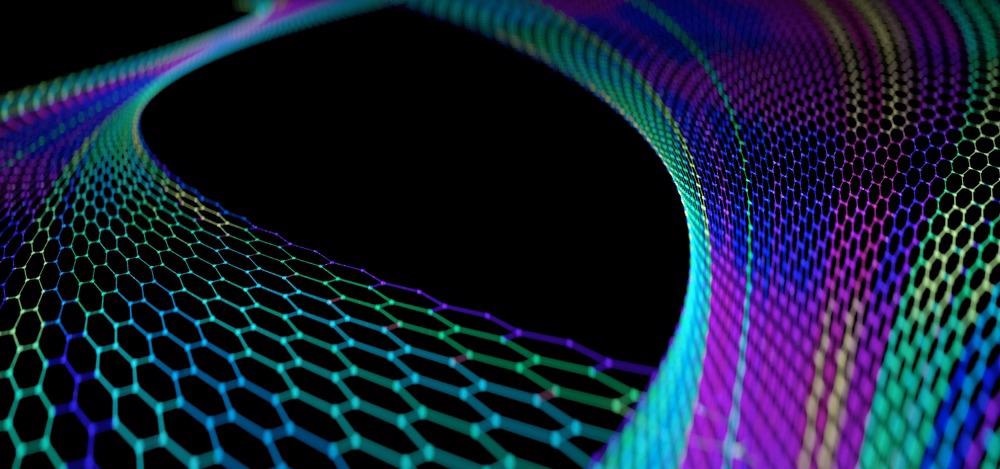Although graphene offers tremendous advantages for plasmon technologies, it is often difficult to co-excite multiple graphene plasmons on a highly dense single graphene sheet. In an article recently published in the journal ACS Nano, the researchers reported heteroepitaxially grown polycrystalline graphene monolayer with patterned gradient grain boundary (GB) density to aid the development of single atomic layer nanoscience, integrated photonics, and optoelectronics.

Study: Engineering Graphene Grain Boundaries for Plasmonic Multi-Excitation and Hotspots. Image Credit: Marco de Benedictis/Shutterstock.com
Graphene GBs
Graphene’s two-dimensionally (2D) correlated quasiparticles that can oscillate collectively make an interdisciplinary field in graphene plasmonics. The graphene plasmons have excellent electromagnetic controllability and confinement that dominate far-infrared and terahertz frequencies. In addition to microfabrication nanostructuring and chemical potential modulation, graphene’s GB serves as a promising candidate to obstruct or reflect the plasmons in real space.
Despite the efficiency of GBs in reconstructing the graphene structure, which facilitates the tuning of graphene plasmonics, it suffers from extreme impurity doping and high-density issues, hindering it from achieving a single graphene monolayer with diverse and dense GB. Thus, the application and influence of GBs on plasmonic modes remains elusive.
Several strategies have been developed to reduce and increase GB density; these strategies were limited to creating growth environments that are homogeneous over the entire substrate, which restricts the diverse GB generation.
Graphene GBs for Plasmonic Multi-excitation and Hotspots
The present study reported the heteroepitaxially grown polycrystalline graphene monolayer with patterned gradient GB density. They employed the chemical vapor deposition method to create various nanosized local growth environments on a substrate of a centimeter scale. These geometries enabled plasmonic co-excitation with the diversification of wavelengths.
The team demonstrated the rich plasmon standing waves and bright plasmonic hotspots using high-resolution scanning nearfield optical microscopy (SNOM). They observed that the local plasmonic wavelengths were tunable by annealing and varying the GB density. Based on theoretical modeling, they inferred that reason for such plasmonic versatility was due to GB-induced phonon-plasmon interactions via the random phase approximation method. The reported seed-induced heteroepitaxial growth is a promising strategy for GB engineering of 2D materials. Furthermore, the GB-based controllable plasmon co-generation and manipulation in a single graphene monolayer facilitates the use of graphene for nanophotonics and plasmonics.
Research Findings
The graphene film ring area’s grain structure was investigated by employing selected-area electron diffraction (SAED) and transmission electron microscopy (TEM). The SAED pattern showed many families of spots that indicated the presence of many differently oriented grains. The researchers obtained a real-space image of grain in a selected orientation via an objective aperture filter. The graphene grain structure’s whole maps were created and were color-coded by a lattice orientation.
The dark-field TEM image showed that the ring area had a gradient grain size structure and on approaching the ring center, the GB density increased. The grain sizes obtained for the outer, ring, and inner area were 140 ± 56, 40 ± 21, and 30 ± 13 nanometers, respectively. The high-resolution TEM characterization with aberration-correction showed that the polycrystalline graphene (PG) rings contained graphene grains devoid of defects and tethered at GBs with pentagons and heptagons.
The fast Fourier transformation pattern revealed differently oriented grains in multiple numbers. The film showed highly crystalline areas with similar morphologies and variation in GB density. The plasmons in inhomogenous PG (IPG) film was studied using SNOM, under an incident infrared (IR) wavelength of approximately 10 micrometers. Based on the dark-field TEM and growth mechanism observations, the team confirmed the formation of high-density GBs inside the hole at the center of the individual graphene domain. They also observed a centrally located large plasmon hotspot in each domain, suggesting that the high-density GB regions are the origin of hotspots.
A nano-Fourier transform infrared (nano-FTIR) spectrum, which was collected from the SNOM tip around the hotspot, was used to demonstrate the local fingerprint spectroscopy. The spectrum showed an IR absorption stronger than pristine silica (SiO2) substrate, indicating the plasmonic absorption from graphene film’s hotspot.
Controlling the GB distribution or annealing the IPG helped achieve the hotspots that were enlarged to an unpredictable size. The excited hotspots in this sample were approximately 1000 nanometers, which was two times larger than pristine samples. Here annealing the IPG enhanced the carrier doping in it.
Conclusion
In conclusion, the researchers demonstrated the IPG film’s controlled growth with a patterned variation in GB density distribution, wherein PG ring seeds were used to create different nanosized local growth environments over a substrate of centimeter size.
The team also demonstrated the co-excitation of various plasmons in such IPGs with wavelength tunability that was measured by employing nearfield optical imaging. These plasmons that are simultaneously excited showed wavelength that increased exponentially and formed large plasmonic hotspots by boosting the GB’s density. Moreover, this plasmonic tunability was due to the plasmon−phonon interactions induced by GB and devoid of magnetic excitation or external gate bias.
Reference
Teng Ma, Baicheng Yao, Zebo Zheng, Zhibo Liu, Wei Ma, Maolin Chen, Huanjun Chen et al (2022). Engineering Graphene Grain Boundaries for Plasmonic Multi-Excitation and Hotspots. ACS Nano. https://pubs.acs.org/doi/10.1021/acsnano.2c00396
Disclaimer: The views expressed here are those of the author expressed in their private capacity and do not necessarily represent the views of AZoM.com Limited T/A AZoNetwork the owner and operator of this website. This disclaimer forms part of the Terms and conditions of use of this website.